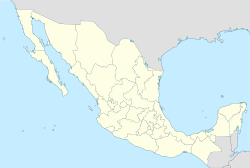- Municipality of Huautla de Jiménez
-
Huautla de Jiménez — Municipality — Coordinates: 18°7′53″N 96°50′27″W / 18.13139°N 96.84083°WCoordinates: 18°7′53″N 96°50′27″W / 18.13139°N 96.84083°W Country Mexico State Oaxaca Municipal seat Huautla de Jiménez Largest city Huautla de Jiménez Government – Municipal president Area – Total 71.45 km2 (27.6 sq mi) Population (2005) – Total 31,829 – Density 445.5/km2 (1,153.8/sq mi) Data source: INEGI Time zone CST (UTC-6) – Summer (DST) CDT (UTC-5) Website (Spanish) Huautla de Jimenez is a town and municipality in the Mexican state of Oaxaca. It is part of the Teotitlán District in the north of the Cañada Region.
The name Huautla comes from the Náhuatl . The town is called "Tejao" (also Eagle's Nest) in the Mazatec language. "De Jiménez" was added to honor General Mariano Jiménez, who was the first governor of the state of Oaxaca in 1884 and the first official to arrive on Mazateca lands. He founded the town Huautla de Jiménez, which is now the municipality's seat.
The origin of the town is unknown, but tribute documents show that it was the largest town in the Mazatec region during the late Postclassic period, when the town paid tribute to the Aztec empire.
The town
The touristic attractions include the waterfall of the watering-can, the hill of Adoration, San Agustin's basement and the caves of San Antonio. Also the people visit the town to buy the endemic hallucinogenic fungi, especially the psilocybin mushroom.[1]
The municipality
The municipality possesses a territorial extension of 71.45 km2. It is located to the northwest of the capital of the state of Oaxaca and it bordered to the north by Santa María Chilchotla and San José Tenango. Tehuacan is the nearest city to this community and it is about 4 hours away.[1]
According to the INEGI census of 2005, the total population of the municipality is of 31,829 inhabitants.[2]
Its principal economic activities are agriculture, ranching and retail shops. The agriculture base consists of coffee, corn, sugar cane and fruit-bearing trees. Ranching consists of goats, cows, pigs, horses and mules. Retail stores include food shops, fruit and vegetable stands, butchers, clothes, footwear, newspapers and magazines, etc. It is noted as the birthplace of María Sabina, a Mazatec medicine woman famous for her use of hallucinogenic fungi. In the 20th century a number of famous people visited here to try it. The municipality has a series of caverns which are some of the deepest in the world, including ‘’’Gruta Nindo Da-Ge’’’, ‘’’Sistema Cheve’’’ and the ‘’’Sótano de San Agustín’’’, which are well-known in the spelunking world. It also has natural springs with crystal-blue waters.[3]
The following communities fall under the governing jurisdiction of the town/municipality:
5 de Mayo, Agua Arco Iris, Agua Álamo, Agua Cabeza de León, Agua Canoa, Agua Caracol, Agua Catitla, Agua de Álamo 1, Agua de Álamo 2, Agua de Carrizo, Agua de Cedro, Agua de Cerro, Agua de Cuerno, Agua de Cueva 1, Agua de Cueva 2, Agua de Estrella, Agua de Flor, Agua de Guayaba, Agua de Hueso (1 ra. Sección), Agua de Hueso (2a. Sección), Agua de la Rosa, Agua de las Flores, Agua de Llano, Agua de Lluvia, Agua de Pluma, Agua de Pozol (San Ramón), Agua de Tierra 1, Agua de Tierra 2, Agua de Tigre, Agua de Tijera, Agua de Tinta, Agua de Yerba Santa, Agua del Monte, Agua Elite (Zoo Yaá n´de), Agua Escalera, Agua Flor Fría 1, Agua Flor Fría 2, Agua Hundida, Agua Iglesia, Agua Neblina, Agua Palmera, Agua Pegado, Agua Sangre, Agua Temazcal, Barranca Seca, Barrio Loma Fortín, Camino Viejo Ayautla, Campo de Aviación Lázaro Cárdenas, Cerro Golondrina, Cerro Iglesia, Cerro Mejía, Cerro Ocote, Cerro Panteón, Cerro Zongolica, Colonia del Valle, Colonia San Rafael, Cruz de Fierro, El Carrizal, Encinal Huautla, Faustino Carrera (Rancho Encinal), Hilatepec Huautla de Jiménez, La Finca, La Providencia, Llano de Águila, Llano de Cedro, Llano de Cedro, Llano de Lodo, Llano Verde, Llano Viejo, Loma Alta, Loma Chapultepec, Loma Chilar, Loma de la Plaza, Loma de Panteón, Loma de Pasto, Loma Frutilla, Loma Maguey, Loma Nazareno, Loma Nopal, Los Pinos, Netzahualcóyotl, Nuevo Progreso 1, Nuevo Progreso 2, Palo de Marca, Patio Iglesia, Peña Campana, Peña del Sol, Peña Verde, Piedra Alta, Piedra Colorada, Plan Carlota, Plan de Arena, Plan de Basura, Plan de Escoba, Plan de Joya, Plan de Lecho, Plan de Ocote, Poza Rica San Andrés, Rancho de Cura, Rancho la Mina, Río Santiago, San Agustín Zaragoza, San Andrés Hidalgo, San Felipe, San Pedro del Río, Santa Catarina Buenavista, Santa Clara, Santa Cruz de Juárez, Sitio Largo, Villa Alta, Xochitonalco, and Zongolica
References
- ^ a b "Huautla de Jiménez" (PDF). http://www.mexicantextiles.com/library/mazateca/huautala.pdf. Retrieved 2008-11-07.
- ^ "INEGI". http://www.inegi.gob.mx/lib/buscador/busqueda.aspx?s=inegi&textoBus=número%20de%20habitantes%20Huautla&i=&e=&seccionBus=docit=. Retrieved 2008-11-07.
- ^ Quintanar Hinojosa, Beatriz (August 2007). "El trópico oaxaqueño". Guía México Desconocido: Oaxaca 137: 86–87. http://www.mexicodesconocido.com.mx.
Eloxochitlán de Flores Magón
Huautepec
Municipality of Huautla de Jiménez
Mazatlán Villa de Flores
San Antonio Nanahuatipam
San Bartolomé Ayautla
San Francisco HuehuetlánSan Jerónimo Tecoatl
San José Tenango
San Juan Coatzospam
San Juan de los Cues
San Lorenzo Cuaunecuiltitla
San Lucas ZoquiapamSan Martín Toxpalan
San Mateo Yoloxochitlan
San Pedro Ocopetatillo
Santa Ana Ateixtlahuaca
Santa Cruz Acatepec
Santa María ChilchotlaSanta María Ixcatlán
Santa María la Asunción
Santa María Tecomavaca
Santa María Teopoxco
Santiago Texcalcingo
Teotitlán de Flores MagónCategories:
Wikimedia Foundation. 2010.


